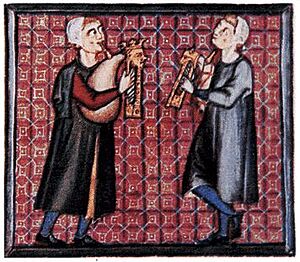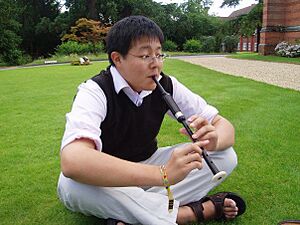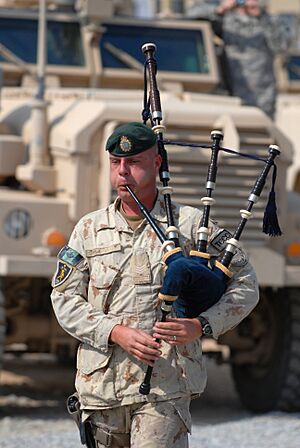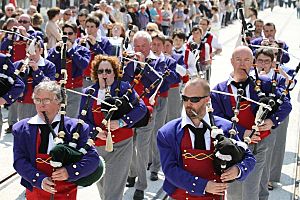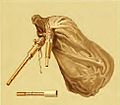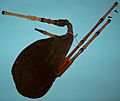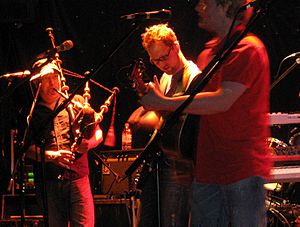Bagpipes facts for kids
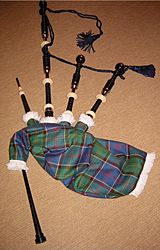
Great Highlands bagpipe
|
|
| Classification | Woodwind |
|---|---|
| Related instruments | |
| Musette | |
The bagpipes are a unique musical instrument. They are sometimes simply called "pipes." Bagpipes have a special bag that holds air. The musician keeps this bag full by blowing into a tube or by using a pump called a bellows. To make music, the player squeezes the bag. This pushes air out through a melody pipe called a "chanter."
Most bagpipes also have one or more other tubes called "drones." These drones make a steady, continuous sound. Each drone usually plays a different note, staying on that note to create a harmony with the chanter's melody. The sounds are made by small vibrating pieces called reeds. These reeds vibrate when air flows over them.
Scotland is very famous for its bagpipes, and many traditional pipe tunes come from there. However, bagpipes are found in many other places too! You can find different types of bagpipes all over Europe, in parts of North Africa, and even in the Middle East. For example, the Scottish Great Pipe, or piob-mohr, first had only one drone pipe. A second pipe was added around the mid-1500s, and a third in the 1700s.
| Top - 0-9 A B C D E F G H I J K L M N O P Q R S T U V W X Y Z |
What Are Bagpipes Made Of?
A basic set of bagpipes has a few main parts. These include a way to supply air, a bag, a chanter (for the melody), and usually at least one drone (for a steady sound). Many bagpipes have more than one drone. Some even have more than one chanter! All these pipes are held in place by "stocks," which are sockets connecting them to the bag.
How Bagpipes Get Air
The most common way to get air into the bag is by blowing into a blowpipe. This is also called a blowstick. Some old pipes required the player to cover the blowpipe tip with their tongue while breathing in. But most modern blowpipes have a special valve. This valve stops air from escaping, so the player doesn't need to use their tongue.
Around the 16th or 17th century, a new idea came along: using a bellows to supply air. These pipes are sometimes called "cauld wind pipes." With bellows, the air isn't warmed or moistened by the player's breath. This means bellows-driven bagpipes can use more delicate reeds. Examples include the Irish uilleann pipes and the Scottish border pipes.
The Bag
The bag is like an airtight balloon. It holds air and helps the player keep a steady sound by squeezing it with their arm. The player keeps the bag inflated by blowing into it or pumping air with a bellows. Bags are often made from animal skins like goat, dog, sheep, or cow.
More recently, bags made from synthetic materials like Gore-Tex have become popular. A downside of synthetic bags is that they can sometimes grow mold if not cleaned properly. This could lead to lung infections. However, a good thing about synthetic bags is that they often have a zipper. This allows players to add a better moisture trap inside the bag.
Bags made from larger pieces of material are usually stitched together. An extra strip is often folded over the seam and stitched or glued to prevent air leaks. Holes are then cut for the stocks. If the bag is made from a whole animal skin, the stocks are usually tied into the spots where the animal's limbs or head would have been. This is common in Central European bagpipes.
The Chanter
The chanter is the pipe that plays the main tune. Players use two hands to play it. Almost all bagpipes have at least one chanter. Some pipes, especially in North Africa, Southern Europe, and Southwest Asia, have two chanters. A chanter can have a straight, "cylindrical" hole inside, or a cone-shaped hole.
Most chanters are open at the end. This means the player can't easily stop the sound. So, most bagpipes have a continuous, smooth sound with no silent breaks. Because of this, players use special finger movements called "embellishments" or "ornaments." These movements break up notes and make it sound like there are pauses or accents. Mastering these embellishments takes many years of practice.
A few bagpipes, like the musette de cour or the uilleann pipes, have closed ends. Or, players can stop the end against their leg. This makes the chanter silent when all holes are covered.
A practice chanter is a chanter without the bag or drones. It lets a player practice quietly without all the other parts. The word chanter comes from the Latin word cantare, meaning "to sing."
Chanter Reeds
The sound from the chanter comes from a reed placed at its top. A reed can be a single reed (with one vibrating part) or a double reed (with two vibrating parts). Double reeds are used with both cone-shaped and cylindrical chanters. Single reeds are mostly used with cylindrical chanters. Generally, double-reed chanters are found in Western European pipes. Single-reed chanters are more common in other regions.
The Drone
Most bagpipes have at least one drone. A drone is a pipe that usually isn't fingered. Instead, it plays a steady, continuous note that goes along with the chanter's melody. This note is usually the main note of the chanter's scale. Bagpipes with two chanters often don't have drones.
A drone is usually a cylindrical tube with a single reed. However, some drones use double reeds. Drones are often made in two or more parts with a sliding joint. This allows the player to adjust the drone's pitch.
Depending on the type of bagpipe, drones might rest over the player's shoulder, across the arm opposite the bag, or run next to the chanter. Some drones have a tuning screw. This screw changes the drone's length by opening a hole, allowing it to be tuned to different pitches. The tuning screw can also turn the drone off completely. In most bagpipes, if there's one drone, it plays two octaves lower than the chanter's main note. Extra drones often add a note one octave lower, and then a note that fits well with the fifth note of the chanter's scale.
The Story of Bagpipes
Ancient Times
It's not totally clear when bagpipes first appeared, but there are some clues from ancient times. The Oxford History of Music suggests that a sculpture of bagpipes was found on a Hittite stone slab in the Middle East, dating back to 1000 BC. Some experts think the ancient Greek askaulos (which means "wine-skin pipe") might have been an early form of bagpipe.
In the 2nd century AD, a writer named Suetonius said that the Roman emperor Nero played the tibia utricularis. Another writer, Dio Chrysostom, wrote in the 1st century about a ruler who could play a pipe by blowing into it and also by tucking a bladder under his arm. These writings suggest that instruments similar to bagpipes existed long ago.
Bagpipes Across Europe
Around the year 1000 AD, clear pictures and descriptions of bagpipes started appearing more often in Western European art. The Cantigas de Santa Maria, a collection of songs from Spain in the mid-1200s, shows several types of bagpipes. More bagpipe pictures are found in a French manuscript from the 13th century.
Bagpipes are even mentioned in The Canterbury Tales, written around 1380 in England:
A baggepype wel coude he blowe and sowne, /And ther-with-al he broghte us out of towne.
—Canterbury Tales
This shows that bagpipes were known in England by then. Bagpipes were also often carved into wooden choir stalls in churches across Europe in the late 1400s and early 1500s. Sometimes, these carvings even showed animals playing them!
It's rare to find actual bagpipes from before the 1700s. However, many paintings, carvings, and drawings survive. These show that bagpipes looked very different across Europe, and even within the same region. Many early folk bagpipes can be seen in paintings by famous artists like Brueghel and Durer.
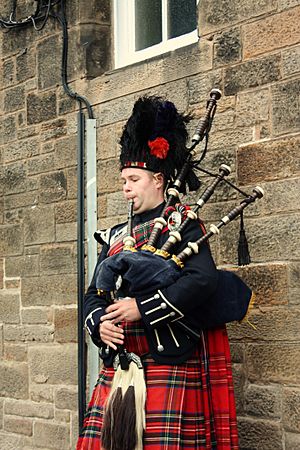
The first clear mention of the Scottish Highland bagpipes being used in battle comes from a French history book. It talks about them being used at the Battle of Pinkie Cleugh in 1547. George Buchanan, a Scottish historian, said that bagpipes had replaced trumpets on the battlefield. This time period saw the creation of ceòl mór (great music) for the bagpipe. This music included battle-tunes, marches, and laments, reflecting its military use. In the 1600s, famous piping families like the MacCrimmonds and MacArthurs developed in the Scottish Highlands.
In Ireland, bagpipes were shown in a book called The Image of Irelande in 1581. This book's pictures are thought to be good examples of what English and Irish people wore and used in the 1500s. A piece of music from 1591 by William Byrd even has a section called The bagpipe: & the drone.
As classical music grew more complex, bagpipes in many areas became less popular. This was because they had a limited range of notes and uses. This led to a slow decline in their popularity, which continued into the 1900s.
Today, you can find large collections of traditional bagpipes in museums. These include the Metropolitan Museum of Art in New York City and the Pitt Rivers Museum in Oxford, England.
Recent Times
During the time of the British Empire, Scottish soldiers often used the Great Highland bagpipe. This made it famous around the world. Its popularity grew even more because many pipers were trained for military service in World War I and World War II. At the same time, many other traditional bagpipes in Europe became less popular. They were replaced by classical instruments, and later by records and radio.
In the United Kingdom and countries like Canada, New Zealand, and Australia, the Great Highland bagpipe is commonly used in the military. It's often played in formal ceremonies. Other countries, like Uganda, India, and Jordan, have also adopted the Highland bagpipe for their military. Many police and fire departments in these countries also have pipe bands.
In recent years, many types of bagpipes have become popular again. This is often thanks to people bringing back traditional folk music and dance. Instruments that were almost forgotten are now very popular. In Brittany, France, people adopted the Great Highland bagpipe and the idea of a pipe band to create their own style called the bagad. The idea of a pipe band has also been used for the Galician gaita in Spain.
Bagpipes have also been used in movies about Scottish and Irish history, like Braveheart. The show Riverdance helped make the uilleann pipes more widely known. Bagpipes are sometimes played at formal events in universities, especially in Canada. Because of Scottish influences on the sport of curling, bagpipes are the official instrument of the World Curling Federation. They are often played during ceremonies before big curling championships.
Making bagpipes used to be a craft that created many unique local styles. Today, Pakistan is the world's biggest producer of bagpipes. In the late 1900s, electronic bagpipes were invented. The first custom-built MIDI bagpipes were created by a Spanish piper named Hevia.
Bagpipes Today
Different Types of Bagpipes
Dozens of types of bagpipes are played today across Europe and the Middle East. They are also found in many parts of the former British Empire. When people hear "bagpipe," they often think of the Great Highland bagpipe. But there are many, many other kinds!
Even though many types of pipes became less popular in the past, many have seen a comeback recently. Musicians are seeking them out again. For example, the Irish piping tradition almost disappeared by the mid-1900s. But today, it is thriving! The same is true for the Asturian gaita, the Galician gaita, and the Northumbrian smallpipes.
Traditionally, bagpipes were often used for dance music. This has changed as dance bands and recordings became popular. This has led to many types of pipes being played more for performances than for dancing. Much modern bagpipe music is no longer suitable for dancing.
Image gallery
-
Cillian Vallely playing Irish Uilleann pipes.
-
Pastoral pipes with a removable footjoint and bellows.
Bagpipes in Modern Music
Since the 1960s, bagpipes have also appeared in many other types of music. These include rock, metal, jazz, hip-hop, punk, and classical music. For example, you can hear bagpipes in Paul McCartney's song "Mull of Kintyre" and AC/DC's "It's a Long Way to the Top (If You Wanna Rock 'n' Roll)". They are also featured in Peter Maxwell Davies's classical piece An Orkney Wedding, with Sunrise.
Images for kids
-
De doedelzakspeler ("Bagpipe Player"), by Hendrick ter Brugghen, 1624.
-
Cillian Vallely playing Irish Uilleann pipes.
-
Kathryn Tickell playing Northumbrian smallpipes.
-
Pastoral pipes with a removable footjoint and bellows.
-
Welsh bagpipes (double-reed type).
-
Bagpipes made in Ab Pakhsh, Iran.
See also
 In Spanish: Gaita para niños
In Spanish: Gaita para niños


